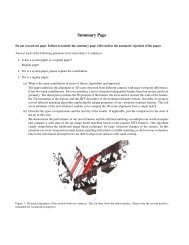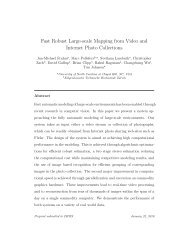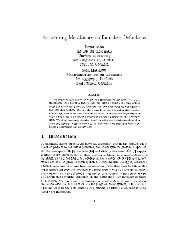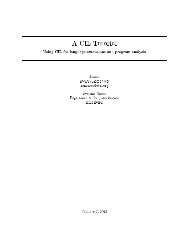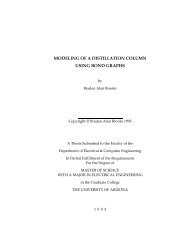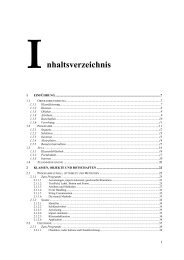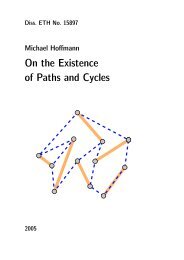How to Write Fast Numerical Code - Department of Computer Science
How to Write Fast Numerical Code - Department of Computer Science
How to Write Fast Numerical Code - Department of Computer Science
You also want an ePaper? Increase the reach of your titles
YUMPU automatically turns print PDFs into web optimized ePapers that Google loves.
<strong>How</strong> <strong>to</strong> <strong>Write</strong> <strong>Fast</strong> <strong>Numerical</strong> <strong>Code</strong><br />
Spring 2012<br />
Lecture 3<br />
Instruc<strong>to</strong>r: Markus Püschel<br />
TA: Georg Ofenbeck
Technicalities<br />
Research project: Let me know<br />
if you know with whom you will work<br />
if you have already a project idea<br />
current status: on the web<br />
Deadline: March 7 th<br />
Finding partner: fastcode-forum@lists.inf.ethz.ch<br />
Recipients: TA Georg + all students that have no partner yet<br />
Email for questions: fastcode@lists.inf.ethz.ch<br />
use for all technical questions<br />
received by me and the TAs = ensures timely answer<br />
© Markus Püschel<br />
<strong>Computer</strong> <strong>Science</strong>
Last Time<br />
Asymp<strong>to</strong>tic analysis versus cost analysis<br />
/* Multiply n x n matrices a and b */<br />
void mmm(double *a, double *b, double *c, int n) {<br />
int i, j, k;<br />
for (i = 0; i < n; i++)<br />
for (j = 0; j < n; j++)<br />
for (k = 0; k < n; k++)<br />
c[i*n+j] += a[i*n + k]*b[k*n + j];<br />
}<br />
Asymp<strong>to</strong>tic runtime: O(n 3 )<br />
Cost: (adds, mults) = (n 3 , n 3 )<br />
Cost: flops = 2n 3<br />
Cost analysis enables performance plots<br />
© Markus Püschel<br />
<strong>Computer</strong> <strong>Science</strong>
Today<br />
Architecture/Microarchitecture<br />
Crucial microarchitectural parameters<br />
Peak performance<br />
© Markus Püschel<br />
<strong>Computer</strong> <strong>Science</strong>
Definitions<br />
Architecture: (also instruction set architecture = ISA) The parts <strong>of</strong> a<br />
processor design that one needs <strong>to</strong> understand <strong>to</strong> write assembly<br />
code.<br />
Examples: instruction set specification, registers<br />
Counterexamples: cache sizes and core frequency<br />
Example ISAs<br />
x86<br />
ia<br />
MIPS<br />
POWER<br />
SPARC<br />
ARM<br />
© Markus Püschel<br />
<strong>Computer</strong> <strong>Science</strong>
MMX:<br />
Multimedia extension<br />
SSE:<br />
Streaming SIMD extension<br />
AVX:<br />
Advanced vec<strong>to</strong>r extensions<br />
Intel x86 Processors<br />
x86-16 8086<br />
x86-32<br />
MMX<br />
SSE<br />
SSE2<br />
SSE3<br />
x86-64 / em64t<br />
SSE4<br />
AVX<br />
286<br />
386<br />
486<br />
Pentium<br />
Pentium MMX<br />
Pentium III<br />
Pentium 4<br />
Pentium 4E<br />
Pentium 4F<br />
Core 2 Duo<br />
Penryn<br />
Core i7 (Nehalem)<br />
Sandybridge<br />
© Markus Püschel<br />
<strong>Computer</strong> <strong>Science</strong><br />
time
ISA SIMD (Single Instruction Multiple Data)<br />
Vec<strong>to</strong>r Extensions<br />
What is it?<br />
Extension <strong>of</strong> the ISA. Data types and instructions for the parallel<br />
computation on short (length 2-8) vec<strong>to</strong>rs <strong>of</strong> integers or floats<br />
Names: MMX, SSE, SSE2, …<br />
Why do they exist?<br />
Useful: Many applications have the necessary fine-grain parallelism<br />
Then: speedup by a fac<strong>to</strong>r close <strong>to</strong> vec<strong>to</strong>r length<br />
Doable: Chip designers have enough transis<strong>to</strong>rs <strong>to</strong> play with<br />
We will have an extra lecture on vec<strong>to</strong>r instructions<br />
What are the problems?<br />
<strong>How</strong> <strong>to</strong> use them efficiently<br />
© Markus Püschel<br />
<strong>Computer</strong> <strong>Science</strong><br />
+ x 4-way
MMX:<br />
Multimedia extension<br />
SSE:<br />
Streaming SIMD extension<br />
AVX:<br />
Advanced vec<strong>to</strong>r extensions<br />
4-way single<br />
2-way double<br />
8-way single, 4-way double<br />
Intel x86 Processors<br />
x86-16 8086<br />
x86-32<br />
MMX<br />
SSE<br />
SSE2<br />
SSE3<br />
x86-64 / em64t<br />
SSE4<br />
AVX<br />
286<br />
386<br />
486<br />
Pentium<br />
Pentium MMX<br />
Pentium III<br />
Pentium 4<br />
Pentium 4E<br />
Pentium 4F<br />
Core 2 Duo<br />
Penryn<br />
Core i7 (Nehalem)<br />
Sandybridge<br />
© Markus Püschel<br />
<strong>Computer</strong> <strong>Science</strong><br />
time
Definitions<br />
Microarchitecture: Implementation <strong>of</strong> the architecture.<br />
Examples: caches, cache structure, CPU frequency, details <strong>of</strong> the<br />
virtual memory system<br />
Examples<br />
Intel processors (Wikipedia)<br />
AMD processors (Wikipedia)<br />
© Markus Püschel<br />
<strong>Computer</strong> <strong>Science</strong>
Microarchitecture:<br />
The View <strong>of</strong> the <strong>Computer</strong> Architect<br />
we take the s<strong>of</strong>tware developers view …<br />
© Markus Püschel<br />
<strong>Computer</strong> <strong>Science</strong><br />
Source: “The Microarchitecture <strong>of</strong> the Pentium 4 Processor, ”<br />
Intel Technology Journal Q1 2001
Show microarchitecture slide<br />
Small runtime bound quiz<br />
© Markus Püschel<br />
<strong>Computer</strong> <strong>Science</strong>
Core Processor<br />
Core 2 Duo Core i7<br />
2 x Core 2 Duo<br />
packaged<br />
Detailed information about Core processors<br />
© Markus Püschel<br />
<strong>Computer</strong> <strong>Science</strong><br />
Pictures: Intel
Core Pipeline<br />
Floating point peak performance?<br />
© Markus Püschel<br />
<strong>Computer</strong> <strong>Science</strong>
Floating Point Peak Performance?<br />
Two different<br />
processor lines<br />
1 or 2 mults/cycle?<br />
1 add/cycle<br />
© Markus Püschel<br />
<strong>Computer</strong> <strong>Science</strong>
The Two Floating Points<br />
float ipf (float x[], float y[], int n) {<br />
int i;<br />
float result = 0.0;<br />
for (i = 0; i < n; i++)<br />
result += x[i]*y[i];<br />
return result;<br />
ipf:<br />
xorps %xmm1, %xmm1<br />
xorl %ecx, %ecx<br />
jmp .L8<br />
.L10:<br />
movslq %ecx,%rax<br />
incl %ecx<br />
movss (%rsi,%rax,4), %xmm0<br />
mulss (%rdi,%rax,4), %xmm0<br />
addss %xmm0, %xmm1<br />
.L8:<br />
cmpl %edx, %ecx<br />
jl .L10<br />
movaps %xmm1, %xmm0<br />
ret<br />
}<br />
…<br />
cmpl %edx,%eax<br />
jge .L3<br />
.L5:<br />
flds (%ebx,%eax,4)<br />
fmuls (%ecx,%eax,4)<br />
faddp<br />
incl %eax<br />
cmpl %edx,%eax<br />
jl .L5<br />
.L3:<br />
movl -4(%ebp),%ebx<br />
movl %ebp, %esp<br />
popl %ebp<br />
ret<br />
© Markus Püschel<br />
<strong>Computer</strong> <strong>Science</strong><br />
standard compilation (SSE) compilation for x87
The Other Floating Point (x87)<br />
His<strong>to</strong>ry<br />
8086: first computer <strong>to</strong> implement IEEE FP<br />
(separate 8087 math coprocessor with floating point unit)<br />
Logically stack based<br />
486: merged FPU and Integer Unit on<strong>to</strong> one chip<br />
Once SSE came out, it was used for floating point<br />
x87 is default on x86-32 (since SSE is not guaranteed)<br />
Became obsolete with x86-64<br />
Floating Point Formats<br />
single precision (C float): 32 bits<br />
double precision (C double): 64 bits<br />
extended precision (C long double): 80 bits<br />
Integer<br />
Unit<br />
© Markus Püschel<br />
<strong>Computer</strong> <strong>Science</strong><br />
Instruction<br />
decoder and<br />
sequencer<br />
Memory<br />
FPU
MMX:<br />
Multimedia extension<br />
SSE:<br />
Streaming SIMD extension<br />
AVX:<br />
Advanced vec<strong>to</strong>r extensions<br />
Intel x86 Processors<br />
X86-16 8086<br />
X86-32<br />
MMX<br />
SSE<br />
SSE2<br />
SSE3<br />
X86-64 / em64t<br />
SSE4<br />
AVX<br />
286<br />
386<br />
486<br />
Pentium<br />
Pentium MMX<br />
Pentium III<br />
Pentium 4<br />
Pentium 4E<br />
Pentium 4F<br />
Core 2 Duo<br />
Penryn<br />
Core i7 (Nehalem)<br />
Sandybridge<br />
© Markus Püschel<br />
<strong>Computer</strong> <strong>Science</strong><br />
time
The Other Floating Point (x87)<br />
His<strong>to</strong>ry<br />
8086: first computer <strong>to</strong> implement IEEE FP<br />
(separate 8087 math coprocessor with floating point unit)<br />
Logically stack based<br />
486: merged FPU and Integer Unit on<strong>to</strong> one chip<br />
Default on x86-32 (since SSE is not guaranteed)<br />
Became obsolete with x86-64<br />
Floating Point Formats<br />
single precision (C float): 32 bits<br />
double precision (C double): 64 bits<br />
extended precision (C long double): 80 bits<br />
Integer<br />
Unit<br />
© Markus Püschel<br />
<strong>Computer</strong> <strong>Science</strong><br />
Instruction<br />
decoder and<br />
sequencer<br />
Memory<br />
FPU
© Markus Püschel<br />
<strong>Computer</strong> <strong>Science</strong><br />
x87 FPU Instructions and Register Stack<br />
Sample instructions:<br />
flds (load single precision)<br />
fmuls (mult single precision)<br />
faddp (add and pop)<br />
8 registers %st(0) - %st(7)<br />
Logically form stack<br />
Top: %st(0)<br />
Bot<strong>to</strong>m disappears (drops out) after <strong>to</strong>o many pushs<br />
Obsolete<br />
%st(3)<br />
%st(2)<br />
%st(1)<br />
“Top” %st(0)
FP <strong>Code</strong> Example (x87)<br />
Inner product <strong>of</strong> two vec<strong>to</strong>rs<br />
Single precision arithmetic<br />
float ipf (float x[],<br />
float y[],<br />
int n) {<br />
int i;<br />
float result = 0.0;<br />
for (i = 0; i < n; i++)<br />
result += x[i]*y[i];<br />
return result;<br />
}<br />
pushl %ebp # setup<br />
movl %esp,%ebp<br />
pushl %ebx<br />
© Markus Püschel<br />
<strong>Computer</strong> <strong>Science</strong><br />
movl 8(%ebp),%ebx # %ebx=&x<br />
movl 12(%ebp),%ecx # %ecx=&y<br />
movl 16(%ebp),%edx # %edx=n<br />
fldz # push +0.0<br />
xorl %eax,%eax # i=0<br />
cmpl %edx,%eax # if i>=n done<br />
jge .L3<br />
.L5:<br />
flds (%ebx,%eax,4) # push x[i]<br />
fmuls (%ecx,%eax,4) # st(0)*=y[i]<br />
faddp # st(1)+=st(0); pop<br />
incl %eax # i++<br />
cmpl %edx,%eax # if i
Core: Floating Point Peak Performance<br />
Scalar:<br />
1 add and 1 mult / cycle<br />
Assume 3 GHz:<br />
6 Gflop/s scalar peak performance on one core<br />
Vec<strong>to</strong>r double precision (SSE)<br />
1 vadd and 1 vmult / cycle (2-way)<br />
Assume 3 GHz:<br />
12 Gflop/s peak performance on one core<br />
Vec<strong>to</strong>r single precision (SSE)<br />
1 vadd and 1 vmult / cycle (4-way)<br />
Assume 3 GHz:<br />
24 Gflop/s peak performance on one core<br />
SSE based FP<br />
x87 FP<br />
© Markus Püschel<br />
<strong>Computer</strong> <strong>Science</strong>
Core: Floating Point Peak Performance<br />
© Markus Püschel<br />
<strong>Computer</strong> <strong>Science</strong><br />
Overall peak on 3 GHz Core 2 and Core i3/i5/i7 Nehalem: (2 cores, SSE)<br />
Double precision: 24 Gflop/s<br />
Single precision: 48 Gflop/s<br />
Overall peak on 3 GHz Core i3/i5/i7 Sandy Bridge: (4 cores, AVX)<br />
Double precision: 96 Gflop/s<br />
Single precision: 192 Gflop/s
Performance in <strong>Numerical</strong> Computing<br />
<strong>Numerical</strong> computing =<br />
computing dominated by floating point operations<br />
Cost measure: usually number <strong>of</strong> floating point ops<br />
Performance measure (in most cases) for a numerical function:<br />
#floating point operations<br />
Makes it possible <strong>to</strong> show percentage <strong>of</strong> peak performance<br />
≈ 90% <strong>of</strong> peak<br />
runtime [s]<br />
unit: flop/s<br />
Peak performance<br />
<strong>of</strong> this computer<br />
© Markus Püschel<br />
<strong>Computer</strong> <strong>Science</strong>



